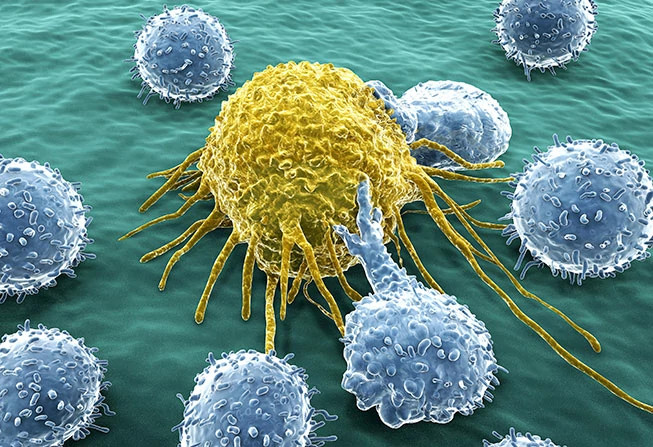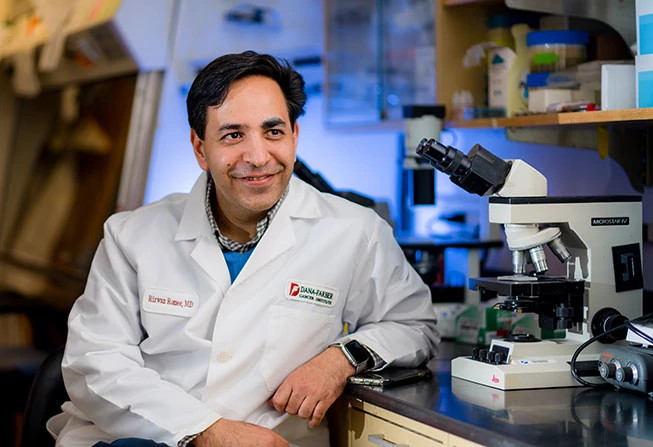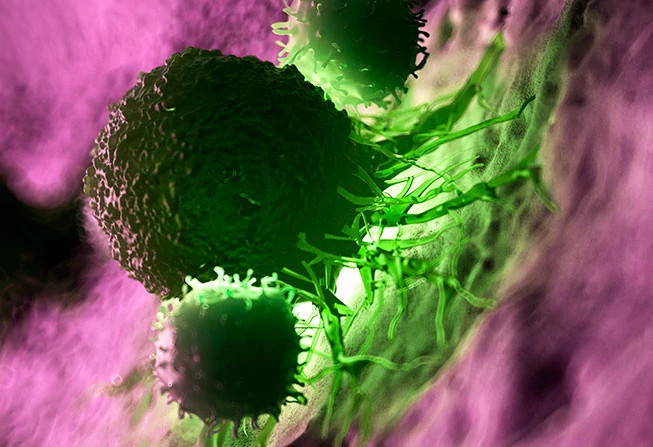Natural Killer Cells
How the Immune System's First Wave of Defense May Play a Newfound Role in Cancer Care
By Robert Levy

As a resident at the University of Minnesota in the late 2000s, Rizwan Romee, MD, witnessed something that, though thoroughly grounded in science, seemed to mingle with the miraculous.
"There was a patient in her 60s with advanced acute myeloid leukemia who hadn't responded to multiple courses of chemotherapy," recalls Romee, now director of the Haploidentical Donor Transplant Program at Dana-Farber. "She had spots – skin lesions – covering most of her body. The attending physician suggested treating her with an infusion of natural killer [NK] cells donated by her son. What happened over the next 48 hours was pretty dramatic: The spots almost completely disappeared, and she went into remission. I thought it was the coolest thing I'd ever seen."
Although the improvement proved to be brief – the patient later died of her disease – Romee was captivated by what he had seen, and by what he sensed as the potential of NK cells as a therapy for cancer. The experience would permanently shape the course of his research.
NK cells are the shock troops of the immune system, the first wave of defenders against infection and disease. They're called natural killers because they don't require any special preparation or training to go on the attack. Like a well-organized strike force, they deploy quickly, do their job, and disperse.
As critical as their role is, their identity was, for many years, obscure. It wasn't until the mid- 1970s that researchers in Sweden discovered that NK cells were a distinct type of white blood cell, rather than a special subset of T cells or B cells, the only kinds of white blood cells known at the time. The late start means that research into NK cells is at a substantially earlier stage than research into T and B cells, which were discovered several decades ago. "In a way, we're in a position of playing catch-up," Romee says. "We're still getting to know NK cells, their capabilities and limitations, and their prospects of being used in cancer treatment."
So, whereas T cells have taken center stage in cancer immunotherapy – as the focus of treatments that sharpen the immune system's attack on cancer – NK cells are still mostly in the wings but edging closer to the spotlight.
In some respects, NK cells have the precise features one would look for in a cancer therapy. They demolish diseased cells with the ruthless cool of a battle bot, tearing holes in the membrane of target cells and injecting enzymes and other molecules that cause the cells to self-destruct. They also can eliminate cancer cells circulating in the body, helping to prevent metastasis.
Despite this proficiency, NK cells have a number of potential drawbacks as cancer-fighters. Unlike T cells, which multiply profusely in order to eliminate infected or diseased cells, NK cells decline to proliferate when infused into patients. This can put them at a sizable disadvantage. "In a patient with cancer, you're dealing not with millions but billions of cancer cells," Romee remarks. "If you're giving a patient a few million NK cells, they would need to divide thousands of times to tackle the tumor adequately, but for the most part, that doesn't happen."

A second shortcoming is the fleeting lifespan of NK cells. "T cells can live for a long time, but NK cells are thought to live for only a few days," Romee notes, "so if you transfer them to a patient they'll quickly be gone."
The differences between T cells and NK cells reflect their very different roles in the immune system's response to disease. NK cells are part of the innate immune system, which handles diseases and infections the body hasn't encountered before. Because they don't rely on a small subset of cells that "remember" previous infections and must proliferate in order to quell new infections, NK cells are ready to attack at a moment's notice. (In this regard, NK cells' refusal to proliferate is a major asset: They essentially sacrifice numbers for speed.) T cells, by contrast, are part of the adaptive immune system. They learn from experience. When they defeat an infectious agent, such as a specific type of bacteria or virus, they're equipped to recognize and battle that agent whenever it returns to the body.
This isn't to say that NK cells are indiscriminate defenders – that, like ill-trained watchdogs, they'll attack any type of intruder. Instead, they take a more targeted approach, just as T cells do. T cells identify infected or cancerous cells based on bits of proteins contained in structures called MHC class I molecules on the surface of many diseased cells. NK cells target cells that don't have MHC class I molecules but instead have tiny SOS flags – called stress ligands – on their surface.
Romee explains: "Infected or cancerous cells oftentimes have a certain group of molecules on their surface yelling for help, saying, basically, 'We are infected, we are malignant, we have stress in our nucleus or genes.' NK cells respond by becoming activated and killing the cells to prevent the infection or disease from spreading."
The differing roles of NK cells and T cells reflect the hand of evolution. Malignant cells often try to avoid a T-cell attack by shedding their MHC class I molecules – the external signs that they are cancerous. This may provide a brief reprieve, but it ultimately lands them in a trap set by the immune system, for an absence of these complexes is precisely what spurs NK cells to go on the attack. "The unique capabilities of NK cells and T cells complement each other," Romee says. "They make it possible for the immune system to recognize a broader array of diseased cells than it could with either NK or T cells alone."
For all their potential, NK cells carry several liabilities as potential workhorses of cancer therapies – namely, their lack of staying power and failure to proliferate when infused into a patient. Their prospects brightened considerably, however, as a result of a series of recent discoveries.

In the mid-2000s, researchers at Washington University found that exposing mouse NK cells to cytokines – immune-signaling substances – endowed them with memory-like properties. In 2012, Romee and his associates demonstrated the same effect in human NK cells. The enhanced cells, dubbed "memory-like NK cells," behave much like T cells. "They gain memory function, they proliferate, and they persist longer within the body than standard NK cells," says Romee.
Research into memory-like NK cells is at an early stage and much remains to be learned about their capabilities and limitations, but their promise is unmistakable. "This is the subject my career revolves around: How do we use these cells to our advantage?" Romee observes.
The recipe for making memory-like NK cells is fast and simple. NK cells – referred to as "regular" NK cells – are collected from the patient or a compatible donor and exposed to cytokines overnight, then infused the next day. "The idea is that most of these primary cells will become memory-like NK cells once they're back in the patient," Romee states. (Ideally, this could be accomplished without collecting NK cells outside the body, but scientists have yet to discover how to coax circulating NK cells safely to become memory-like. It's a challenge they're avidly pursuing.)
NK cells received one of their first tests as a cancer therapy in a small clinical trial led by Romee. The trial involved patients with advanced acute myelogenous leukemia (AML) or myelodysplastic syndrome (MDS, a bone marrow disorder that leads to a shortage of healthy blood cells) who hadn't responded to at least three courses of chemotherapy. The goal was to see whether memory-like NK cells derived from patients' family members could produce remissions.
The results were impressive by any standard. More than half the patients went into remission – "remarkable in patients with advanced disease who aren't responding to chemotherapy," Romee says. The infused cells lasted longer in patients than ordinary NK cells would, researchers found, and patients experienced hardly any negative side effects.
The trial, like all phase 1 trials, focused primarily on the treatment's safety, and most of the patients eventually relapsed. Investigators theorize that patients' own immune system eventually kills the donor NK cells, limiting the time they can be active within the body. For that reason, researchers see two futures for NK cell therapies: one, as a means of sending blood-related cancers into remission so patients can be eligible for a stem cell transplant; and, two, making memory-like NK cells from a close family member and combining them with a stem cell transplant from the same donor to increase the transplant's chances of success.
At Dana-Farber, Romee has spearheaded the creation of an NK cell program that includes both laboratory and clinical research. He and his colleagues expect to open a trial in which patients who have relapsed after undergoing a transplant from a partially matched donor receive NK cells from the same donor in an effort to regain remission. A trial in the planning stages would use memory-like NK cells to eliminate tumor cells carrying specific genetic mutations, thereby making transplant more effective. In the lab, researchers are studying novel agents to make memory-like NK cells work even better.
"We've also started brainstorming about using NK cells for non-hematologic [blood-related] cancers," Romee remarks. "We're collaborating with Dana-Farber specialists in melanoma and head and neck cancers to develop NK-cell clinical trials for patients with advanced forms of those diseases."
There are even efforts to create NK-cell versions of CAR T cells – the genetically engineered T cells that are programmed to attack specific types of cancer cells. "We're still at a very early stage of NK cell research," Romee says. "There's a sense that we've only scratched the surface of their potential."
Other Feature Stories from Paths of Progress 2019
-
Wrench in the Works
Stopping cancer's mechanism of cell division with new drugs known as CDK4/6 inhibitors.
-
Cancer, Interrupted
Uncovering new strategies for identifying signs of pre-cancer – and stopping it before it starts.
-
Compound Growth
Chemical biologists create small molecules to boost discoveries and prototype novel therapies.
To see the entire publication, please download the PDF version.
Request a Publication
Receive by mail the current issue of a Dana-Farber publication by completing this request form.
Media Contacts
If you are a journalist and have a question about any of our stories or need more information, email media@dfci.harvard.edu or call 617-632-4090 and ask to speak to a member of the media team.
The Media Team cannot respond to patient inquiries. For more information on contacting Dana-Farber, please see Contact Us.
Disclosure of Advisory Roles and Certain Industry Support
See an overview of relevant board memberships, outside support, and significant advisory roles as reported by several physicians and researchers featured in the 2019 issue of Dana-Farber's Paths of Progress magazine.